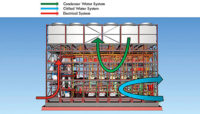School, warehouse, office building … the boiler stories they tell put the focus back on specific circumstances and smart pre-design study to ensure their systems (and budgets) enjoy the best of times for as long as possible.
There is a widely held belief that high efficiency is always best. However, this is not necessarily the case.
When it comes to designing a boiler plant, for example, there are a number of variables that will determine if a high-efficiency boiler is optimal. Will it be installed in a new building or retrofitted into an existing building? Is the plant in a location with high or low natural gas prices? What is the availability and capability of operations and maintenance staff? With a retrofit, what is the current state of pumps and piping in the facility, and what temperature water does the existing equipment require?
Short of the owner or facility operator playing a costly version of Goldilocks (will this, that, or the other boiler work?), basic principles of boiler system design, when combined with specific project requirements and building parameters, can inform the design team’s decision between a modern, high-efficiency boiler plant and more traditional equipment designs.
Chicago-based McGuire Engineers recently designed three different boiler plants in the Chicago area — one for a new, high-efficiency school, another for an existing downtown high-rise office, and a third that supports a big box retailer’s legacy distribution warehouse. Come explore the boiler plant requirements and final outcomes, including the thought process behind how McGuire arrived at each solution.
Case I: Lycée Françis de Chicago
The new 86,000-sq-ft, LEED Silver Lycée Françis de Chicago (LFC) is home to 700 students from preschool through 12th grade. Opening in 2015, the building was designed with high-performance equipment, including a high-efficiency, three-boiler, 3,000-MBH condensing boiler plant. The HVAC system design for the four-story building uses five VAV rooftop units with hot water reheat terminal VAV units and fin-tube convection heat at storefront windows.
The boilers operate year-round, with varying loads ranging from small VAV hot water reheat loads in the summer to full heating on a cold winter day. The fin-tube radiators and VAV reheat coils were selected to operate at a 30 degree ∆T, which allows the high-efficiency boilers to take full advantage of condensing mode operation.
Condensing boilers use low-return water temperatures to capture the latent heat stored in the water vapors produced during combustion by allowing those vapors to condense. The challenge in condensing flue gasses is that they are acidic, with a PH in the range of three to five for natural gas and as low as two for oil-fired boilers. Traditionally constructed boilers must operate at a temperature high enough to limit the potential for any of this acidic condensation to collect, resulting in corrosion and early failure of the heat exchanger. As a result, this energy must be sacrificed and exhausted out of the building. Boilers capable of condensing have heat exchangers constructed of more resilient materials to withstand the accumulation of the acidic condensation, which come with an increase in equipment cost.
A successful condensing boiler plant will save more money through efficient operation than its increased first cost. As part of maximizing these savings for the owner, it is important to keep the return water temperature only as warm as is needed to get the heating job done. The lower the return water temperature, the more energy can be captured from the flue gasses, as can be seen in Figure 1. This means that a temperature reset schedule will allow for the same comfort at lower water temperatures for the majority of the year.
Utilizing a supply water temperature reset schedule allows this to automatically happen, dropping the set point from 180°F to 100°F, based on the outdoor air temperature. Instead of operating at the 80 to 85% efficiency of a non-condensing boiler, the relatively small, low-water volume condensing boilers operate at an efficiency of 87 to 95%. The boilers are located in a roof-mounted boiler penthouse that includes pumps and a small buffer tank to ensure a sufficient water volume. The low weight of the boilers gave the design team the flexibility to locate the plant on the roof with minimal structural concerns. The economics of a condensing boiler plant in an owner-occupied newly constructed building in cool climates can be highly favorable.
Commissioning (Cx) the boiler plant and adequately training the maintenance staff on how to use it are key to achieving ongoing operational efficiencies. At LFC, the Cx agent worked with the building owner and design team to train team members on how to operate and maintain the boiler plant for effective, long-term equipment life and optimal operational efficiencies.
Case II: Downtown Chicago high-rise office building
A 430,000-sq-ft Chicago high-rise office building built in the 1970s replaced its legacy equipment with a near-condensing 86% efficient low-mass boiler plant. While a low-volume, high-efficiency boiler recipe was ideal for Case I, when installed in this 50-year-old high-rise, the boilers failed after just a few years. Why?
The original boiler plant was designed to support the main building with expansion capability for a future second building that was never connected. One of the two original Scotch marine boilers was replaced with four 3,000 MBH boilers, while the second original boiler was retained for backup. Oversized piping designed for two buildings, but only serving one, resulted in long-term operation at water velocities below ASHRAE recommendations. Over the years, air, scale, and other sediment had collected in the piping system. These water quality issues led to irregular flow at the boilers, resulting in thermal shock and ultimately premature heat exchanger failure. The original boiler plant was designed with a constant flow, primary only pumping configuration, which was not altered when the smaller boilers were installed.
The McGuire solution was to replace the high-efficiency boilers with equivalent efficiency, high-volume, high-mass, non-condensing boilers. Three boilers sized at 4,000 MBH were chosen to match the capacity of the four failed boilers, while providing space and connections for the addition of a fourth redundant boiler should the building choose to remove the second original 50-year-old backup Scotch marine boiler. Each of the new fire tube, 300-gal, 7,100-lb boilers has a dedicated pump that turns on before the boiler ignites to ensure the flow of water before boiler ignition. To ensure success, the piping configuration was changed to include a constant primary, variable secondary loop. This allowed the MEP design team to control the temperature and flow of water in the primary loop independent of the building’s load as well as the temperature necessary for the non-condensing boiler to ensure the required flow for the boilers. Improved air venting and a side stream filter were added to address the water quality. All together, these changes made the plant more reliable.
So, what about energy efficiency?
The original design of the building was based on a 200°F supply water temperature with a 180°F return water temperature. Even though the boiler isn’t highest-efficiency, the three-pass boiler features 83% efficiencies. Given the coil selections throughout the building, there are very few (if any) hours during the year where condensing operation could be utilized. While the increased heat exchanger surface area in a condensing boiler will yield improved efficiency under any circumstance, the increased cost cannot be justified without substantial time spent in the condensing water temperature range. Improved efficiencies can be seen through the addition of a VFD on the secondary water loop side.
Case III: Office and distribution warehouse
Constructed in the 1980s, the four-story, office building and accompanying 350,000-sq-ft regional distribution center for a supermarket’s Midwest operations was outfitted with two non-condensing 13,400 MBH boilers and a constant flow, primary only pumping system. The owner needed to replace the aging infrastructure and wanted to move to a more efficient system.
Like the downtown high-rise, two large boilers serviced this facility for years. McGuire developed an energy model of the building to understand the potential savings and ultimately select the most effective solution. The model included the office building’s perimeter convection units, VAV reheat coils, and the warehouse’s fan coil heating. The energy model allowed design engineers to evaluate the use of different boilers and systems, comparing and contrasting them to determine potential payback and rebate scenarios.
The analysis found that an investment in high-performing condensing boilers would yield a 10-yr payback when compared with the installation of a standard efficiency plant. While the owner was motivated to choose high-efficiency boilers, the payback could not justify the expense. It was found that the infrastructure budget was better invested in upgrading the pumping system to variable flow. [NOTE: The payback estimate here is specific to the facility’s Midwest location, where natural gas prices have come down significantly. For many years, conventional wisdom dictated that natural gas prices would continue to increase over time. The advent of fracking and other market drivers has instead dropped natural gas prices to those last seen a decade ago, as can be seen in Figure 2. Conducting an energy analysis is important to justify the additional expense of a high-efficiency system no matter where the building is located.]
Unlike Case II, water quality was not an issue, and therefore, a water tube boiler with medium water volume level was employed. It was determined that the payback for the more costly condensing boilers weren’t warranted. In this case and in Case II, the non-condensing boilers don’t allow for drops in water temperature. Instead, it’s important to maintain a return water temperature above the 140°F due point of the flue gas to avoid condensing. The building’s original design requires water that is 180°F with a 160°F return water temperature in cold weather.
Ultimately, McGuire paired a pump with each of the four 4,000 MBH boilers specified for the retrofit. This best practice ensures that water is always moving through the pipe so the boiler heat exchanger can’t overheat. The final piping configuration is comprised of a constant primary, variable secondary loop. Conversion of the secondary loop to variable flow includes the replacement of the secondary loop pumps, addition of VFDs with differential pressure sensors at several “long leg” points, removal of bypasses, and conversion of a number of 3-way valves to 2-way valves. The selected water tube boilers have an 80% operating efficiency and a long service life with readily replaceable tubes. The new boilers also match the equipment installed in other corporate sites, simplifying replacement part stock and operations and maintenance across the company’s fleet of warehouses.
It is also important to consider building system operators in regards to existing equipment requirements and the skill set required of the new equipment, as operators will be working within existing building limitations. In this case, operators were involved in the retrofit decision making process and trained on new equipment.
High efficiency isn’t always better
While high-efficiency equipment gets a lot of press today, sometimes — and even oftentimes — the right “high performance” solution is the one that’s really “nothing special” in terms of efficiency, but the right fit for optimal, long-term operation. The typical boiler plant is still a good answer to the challenges most facilities face. In the end, squeezing every Btu out of the system is an important goal, but not the only goal.
Compare and contrast the project requirements with the realities of the infrastructure. That being said, it’s not a question that new facilities designed for high-performance MEP systems operation can and should support high-efficiency boiler plants. Understanding the parameters, functions, and requirements of each facility are key to designing a boiler plant for successful operation long term — without having to investigate Goldilocks-style. ES







